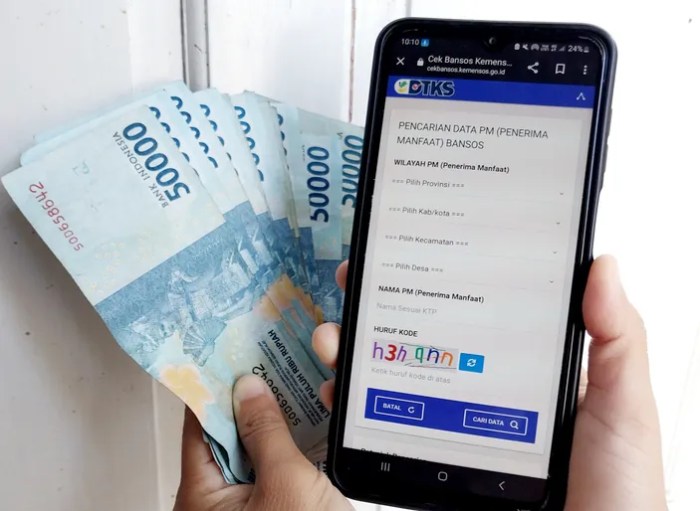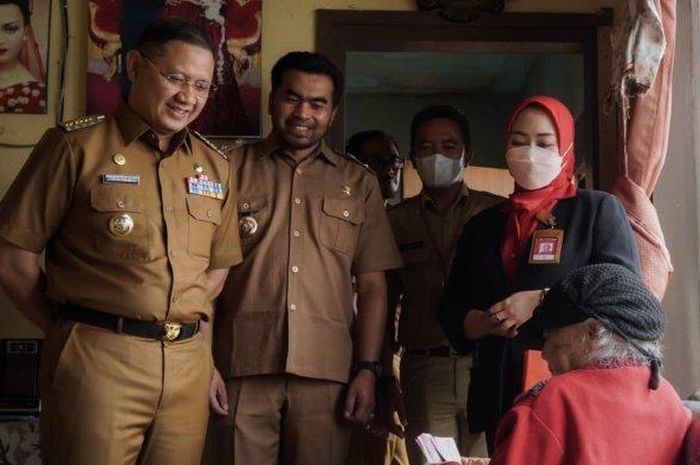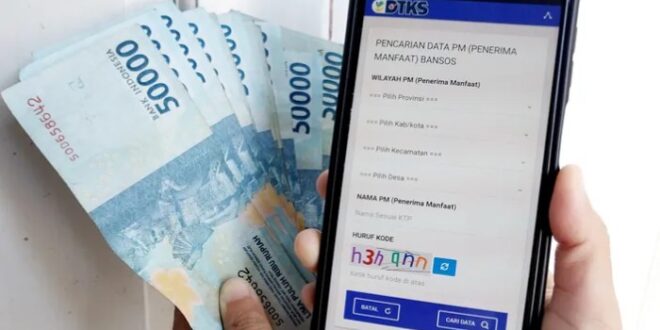Bantuan BLT PKH 2025: Jaring Pengaman Sosial untuk Keluarga Indonesia
Bantuan BLT PKH 2025 – Program Bantuan Langsung Tunai Program Keluarga Harapan (BLT PKH) 2025 merupakan program pemerintah yang dirancang untuk mengurangi angka kemiskinan dan meningkatkan kesejahteraan keluarga kurang mampu di Indonesia. Program ini memberikan bantuan finansial secara langsung kepada keluarga penerima manfaat (KPM) yang memenuhi kriteria tertentu, membantu mereka memenuhi kebutuhan dasar dan meningkatkan kualitas hidup. BLT PKH 2025 diharapkan menjadi pilar penting dalam mewujudkan Indonesia yang lebih adil dan sejahtera.
Berbeda dengan program bantuan sosial lainnya, BLT PKH memiliki pendekatan holistik yang tidak hanya memberikan bantuan finansial, tetapi juga pendampingan dan edukasi untuk pemberdayaan keluarga. Hal ini bertujuan agar bantuan yang diberikan tidak hanya bersifat sementara, tetapi juga dapat meningkatkan kemampuan KPM untuk keluar dari jeratan kemiskinan secara berkelanjutan.
Tujuan dan Sasaran BLT PKH 2025
BLT PKH 2025 bertujuan untuk meningkatkan taraf hidup keluarga miskin dan rentan melalui pemberian bantuan tunai yang diiringi dengan pendampingan. Sasaran utamanya adalah keluarga yang memiliki anak usia dini, ibu hamil, anak sekolah, penyandang disabilitas, dan lanjut usia. Dengan memberikan bantuan kepada kelompok-kelompok rentan ini, diharapkan dampaknya dapat dirasakan secara luas dan merata.
Kelompok Masyarakat Penerima Bantuan
Penerima bantuan BLT PKH 2025 adalah keluarga yang terdaftar dalam Data Terpadu Kesejahteraan Sosial (DTKS). Kriteria penerima meliputi keluarga miskin dan rentan yang memiliki anggota keluarga yang masuk dalam kategori: anak usia dini (0-6 tahun), ibu hamil, anak sekolah (SD, SMP, SMA/SMK), penyandang disabilitas, dan lanjut usia. Proses verifikasi dan validasi data dilakukan secara ketat untuk memastikan bantuan tepat sasaran.
- Anak usia dini (0-6 tahun): Mendapatkan bantuan untuk pemenuhan gizi dan stimulasi perkembangan anak.
- Ibu hamil: Mendapatkan bantuan untuk menjaga kesehatan ibu dan janin selama kehamilan.
- Anak sekolah (SD, SMP, SMA/SMK): Mendapatkan bantuan untuk biaya pendidikan, mengurangi beban biaya sekolah dan meningkatkan angka partisipasi pendidikan.
- Penyandang disabilitas: Mendapatkan bantuan untuk memenuhi kebutuhan khusus dan meningkatkan kesejahteraan.
- Lanjut usia: Mendapatkan bantuan untuk memenuhi kebutuhan hidup sehari-hari.
Mekanisme Penyaluran Bantuan BLT PKH 2025
Bantuan BLT PKH 2025 disalurkan secara bertahap melalui rekening bank atau kantor pos yang telah ditentukan. KPM akan menerima informasi terkait jadwal dan mekanisme pencairan melalui petugas pendamping PKH atau melalui pesan singkat (SMS). Proses penyaluran bantuan dilakukan secara transparan dan akuntabel untuk mencegah penyelewengan.
Sejarah dan Perkembangan BLT PKH hingga Tahun 2025
Program PKH telah berjalan sejak tahun 2007 dan terus mengalami perkembangan dan penyempurnaan. Awalnya, program ini fokus pada pemberian bantuan tunai kepada keluarga miskin. Seiring berjalannya waktu, program ini semakin terintegrasi dengan program-program lainnya dan semakin fokus pada pemberdayaan keluarga melalui pendampingan dan edukasi. Program PKH 2025 merupakan kelanjutan dari komitmen pemerintah untuk meningkatkan kesejahteraan masyarakat melalui bantuan sosial yang terarah dan tepat sasaran. Data menunjukkan peningkatan signifikan dalam akses pendidikan dan kesehatan keluarga penerima manfaat dari tahun ke tahun.
Contohnya, pada tahun 2024, tercatat peningkatan jumlah anak yang melanjutkan pendidikan ke jenjang yang lebih tinggi di keluarga penerima manfaat PKH. Hal ini menunjukkan keberhasilan program dalam meningkatkan akses pendidikan dan mengurangi angka putus sekolah.
Persyaratan dan Kriteria Penerima BLT PKH 2025

Raih kesempatan emas untuk mendapatkan Bantuan Langsung Tunai Program Keluarga Harapan (BLT PKH) 2025! Program ini dirancang untuk meningkatkan kesejahteraan keluarga kurang mampu. Ketahui persyaratan dan kriteria penerima agar Anda dapat mempersiapkan diri dan mengajukan permohonan.
Persyaratan dan Kriteria Penerima BLT PKH 2025
Penerima BLT PKH 2025 akan dipilih berdasarkan kriteria ketat yang memastikan bantuan tepat sasaran. Kriteria ini meliputi faktor-faktor seperti usia, pendidikan, pekerjaan, dan pendapatan keluarga. Proses verifikasi data yang teliti akan dilakukan untuk memastikan keakuratan informasi dan mencegah penyalahgunaan bantuan.
Proses Verifikasi dan Validasi Data Penerima BLT PKH 2025
Data calon penerima BLT PKH 2025 akan diverifikasi dan divalidasi melalui beberapa tahap. Tim verifikator akan melakukan pengecekan lapangan untuk memastikan kecocokan data yang dilaporkan dengan kondisi riil di lapangan. Proses ini melibatkan kerjasama dengan berbagai pihak, termasuk pemerintah daerah dan lembaga terkait, guna memastikan transparansi dan akuntabilitas program.
Perbandingan Persyaratan Penerima BLT PKH Antar Tahun
Berikut tabel perbandingan persyaratan penerima BLT PKH antar tahun. Perlu diingat bahwa persyaratan ini dapat berubah sesuai kebijakan pemerintah. Informasi ini bersifat umum dan dapat berbeda di setiap daerah.
| Tahun | Syarat Usia | Syarat Pendidikan | Syarat Pekerjaan | Syarat Pendapatan |
|---|---|---|---|---|
| 2023 | Variatif, bergantung kategori penerima | Variatif, bergantung kategori penerima | Tidak bekerja/bekerja informal dengan penghasilan rendah | Dibawah UMR |
| 2024 | Variatif, bergantung kategori penerima | Variatif, bergantung kategori penerima | Tidak bekerja/bekerja informal dengan penghasilan rendah | Dibawah UMR |
| 2025 (Perkiraan) | Mungkin ada penyesuaian, bergantung kategori penerima | Mungkin ada penyesuaian, bergantung kategori penerima | Tidak bekerja/bekerja informal dengan penghasilan rendah | Dibawah UMR |
Persyaratan Tambahan di Beberapa Daerah
- Beberapa daerah mungkin menerapkan persyaratan tambahan, seperti kepemilikan Kartu Keluarga Sejahtera (KKS) atau bukti tinggal di wilayah tersebut.
- Persyaratan kepemilikan rumah dan tanah juga mungkin menjadi pertimbangan di beberapa daerah.
- Kriteria tambahan bisa juga mencakup kondisi kesehatan anggota keluarga atau akses terhadap fasilitas umum.
Alur Pendaftaran dan Proses Pengajuan BLT PKH 2025
- Kunjungi kantor desa/kelurahan setempat untuk mendaftar dan mendapatkan informasi lebih lanjut.
- Siapkan dokumen persyaratan yang dibutuhkan, seperti Kartu Keluarga (KK), Kartu Tanda Penduduk (KTP), dan dokumen pendukung lainnya.
- Isi formulir pendaftaran dengan lengkap dan akurat.
- Serahkan berkas pendaftaran kepada petugas yang berwenang.
- Tunggu proses verifikasi dan validasi data oleh petugas.
- Jika dinyatakan lolos, Anda akan menerima pemberitahuan dan bantuan BLT PKH 2025.
Besaran dan Jadwal Pencairan BLT PKH 2025: Bantuan BLT PKH 2025

Program Keluarga Harapan (PKH) 2025 hadir kembali dengan komitmen untuk meningkatkan kesejahteraan keluarga kurang mampu. Informasi mengenai besaran bantuan dan jadwal pencairan sangat penting bagi para penerima manfaat agar dapat mempersiapkan diri dan memanfaatkan bantuan ini secara efektif. Berikut detailnya:
Besaran Bantuan BLT PKH 2025 per Kategori
Besaran bantuan PKH 2025 disesuaikan dengan kategori penerima dan kebutuhan masing-masing keluarga. Angka-angka berikut merupakan proyeksi dan dapat berubah sesuai kebijakan pemerintah. Selalu cek informasi resmi dari Kementerian Sosial untuk data terbaru.
- Ibu Hamil/Nifas: Rp3.000.000 per tahun, dicairkan per tahap sebesar Rp750.000.
- Anak Usia Dini (0-6 tahun): Rp3.000.000 per tahun, dicairkan per tahap sebesar Rp750.000.
- Anak Sekolah SD/Sederajat: Rp900.000 per tahun, dicairkan per tahap sebesar Rp225.000.
- Anak Sekolah SMP/Sederajat: Rp1.500.000 per tahun, dicairkan per tahap sebesar Rp375.000.
- Anak Sekolah SMA/Sederajat: Rp2.000.000 per tahun, dicairkan per tahap sebesar Rp500.000.
- Penyandang Disabilitas Berat: Rp2.400.000 per tahun, dicairkan per tahap sebesar Rp600.000.
- Lansia Usia 70 Tahun ke Atas: Rp2.400.000 per tahun, dicairkan per tahap sebesar Rp600.000.
Catatan: Jumlah bantuan dapat bervariasi tergantung pada jumlah anggota keluarga yang termasuk dalam kategori penerima bantuan.
Jadwal Pencairan BLT PKH 2025
Pencairan BLT PKH 2025 direncanakan dilakukan dalam empat tahap sepanjang tahun. Jadwal pastinya akan diumumkan secara resmi oleh pemerintah. Berikut proyeksi jadwal pencairan:
| Tahap | Periode Pencairan |
|---|---|
| Tahap 1 | Januari – Maret |
| Tahap 2 | April – Juni |
| Tahap 3 | Juli – September |
| Tahap 4 | Oktober – Desember |
Catatan: Jadwal ini bersifat sementara dan dapat berubah sewaktu-waktu. Penting untuk selalu memantau informasi resmi dari Kementerian Sosial.
Ilustrasi Besaran Bantuan dan Jadwal Pencairan BLT PKH 2025, Bantuan BLT PKH 2025
Bayangkan sebuah infografis yang menampilkan tabel dengan kolom kategori penerima dan besaran bantuan per tahap. Bagan tersebut juga akan menunjukkan timeline pencairan bantuan dalam empat tahap sepanjang tahun. Warna-warna cerah dan ikon yang menarik akan digunakan untuk memudahkan pemahaman visual. Data akan disajikan dengan jelas dan ringkas, memastikan informasi mudah dicerna oleh semua kalangan.
Metode Pencairan BLT PKH 2025
Pencairan BLT PKH 2025 akan dilakukan secara digital dan terintegrasi untuk memastikan transparansi dan efisiensi. Metode pencairan utama adalah melalui transfer langsung ke rekening bank/e-wallet yang telah terdaftar. Kemungkinan penyaluran melalui kantor pos masih menjadi opsi untuk daerah yang memiliki keterbatasan akses perbankan.
Potensi Kendala dan Solusi Pencairan BLT PKH 2025
Potensi kendala yang mungkin terjadi meliputi kesalahan data penerima, kendala akses perbankan, dan keterlambatan penyaluran. Untuk mengatasi hal tersebut, pemerintah akan melakukan verifikasi data secara ketat, meningkatkan literasi digital bagi penerima manfaat, dan memperkuat koordinasi antar instansi terkait untuk memastikan penyaluran bantuan tepat sasaran dan tepat waktu. Layanan call center dan bantuan teknis juga akan tersedia untuk membantu mengatasi kendala yang dihadapi penerima manfaat.



